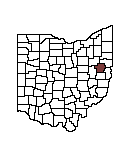County History as reported
in The Free Press Standard in 1933
Wild Indians, Hungry Wolves Menaced Pioneer Settlers
Early Hardships Related In First Installment of County History
(Reprinted from issue of December 26, 1883)
Carroll-co was formed out of portions of the old counties of Columbiana, Harrison, Jefferson, Tuscarawas and Stark by the Ohio legislature at its session in the winter of 1832-3, and named in honor of Charles Carroll, of Carrollton, Maryland -- the last surviving signer of the Declaration of Independence -- who died the same year the county was created; so that Carroll-co has now passed the first half century of its separate existence.
First Settlements
The first settlements within the present limits of the county were made about the year 1800, by persons who came from Maryland, Pennsylvania and Virginia, who carried with them cherished recollections of their native states, as may be supposed from the names given to the towns of New Hagerstown, Carrollton, New Harrisburg and Loudon township. The first few years after the pioneer settlement had been made were marked by few disturbances of a serious nature, although there are records of numerous cases of hardship and bravery. The Indians committed occasional depredations, but were generally peaceable. Arrow heads, tomahawks and other implements were abundant as relics at this time. Wild animals were very common, particularly bears, deer and wolves. Particular mention is made of a deer having been shot on the present site of the court house and part of the same dressed and roasted near a spring in the rear of where Stockon's drug store has since been built.
The homes of the early settlers were of peculiar structure; in size ranging from fifteen to twenty feet square, and usually not over ten feet in height, yet containing a story and a half, the lower one not over six and a half or seven feet in height, making it necessary for a tall person to remover their hat in order to assume and erect attitude. The roof was generally of clapboard, the floor of puncheon, and the door swinging upon wooden hinges, fastened with a wooden latch. Such a home was occupied until a few years ago by Valentine Friday, who afterwards lived and died on the Harlem road, who told the writer that in early times he had driven hungry wolves away from his door with a burning knott of wood.
Some of the relics of these early settlements still withstand the destroying hand of time; the old orchards, the same spring of water, and remains of the old homestead cabin, mark the spot where these pioneer heroes lived and died, and with some of them the plowshare, with an iconoclastic indifference, has long since obliterated every trace of their place of interment.
Early Anecdotes
A noted Indian chief, named Captain Pipe was in this locality at the clearing up of Carroll-co, and although generally quite peaceable, he was fond of liquor, and would murder at times. When drunk he would boast of his bravery in this direction. In 1811 he suddenly disappeared. Sometime afterward an Indian skull and gun barrell were found on J. Dunlap's farm on the bank of Pipe Run. Some human bones were also found there; and it was the popular belief that the neighborhood that these were the remains of Captain Pipe, who had been "removed" by a "pale face" in this vicinity.
Adam Poe, who had the fight with the Big Foot Indian, crossed this county form his home in Tuscarawas-co and staid all night near Morges, on his way to a Whig meeting at Massillon in 1840. There are men still living in this county who can relate to a full account of this man, Poe's encounter with the Indian, as given by his own lips.
On William Elder's farm in Harrison-tp there is considerable of a waterfall, below which there was found a few years ago some bones of a deer, which had been split open, evidently for the purpose of extracting the fatty matter -- as it is generally known that wild animals do not have much fat, except the marrow.
D. M. Coleman has a spot marked on McCulley's Hill, near the road leading from New Harrisburg to Carrollton where a child is buried that had been killed by Indians. The parents desiring to reach the Ohio river were so closely pursued that they were compelled to bury the corpse before reaching home.
Mastodon Teeth Found
Among other scraps of history that have been kindly furnished us, we recite that Jonas Kintner found the bones of a bear and a human skelton side by side on the east end of Carrollton a few years ago, evincing the possibility of a death struggle between the two at some remote period. The Geological Report of Carroll-co recites that "in the Sandy Creek bottom, not far from Waynesburg, Daniel Wagner found two teeth of a Mastodon, of large size and nearly perfect weighing together fifteen pounds;" and a tooth of large size was lately found by W. H. Morgan near the canal lock at Oneida -- illustrating, by comparative anatomy, the species of fauna that roamed these wilds in pre-historic times.
Gnadenhutten Massacre
The struggles of the patriots with the Indian tribes following the War of the Revolution made it necessary for the government to send troops to what was then the frontier, to guard the early settlers and the Missionary stations; prominent among which in this part of Ohio was the Moravian Mission at Gnadenhutten, where ninety Christian Indians were murdered in 1782. A detachment of troops was sent out from Fort Pitt (now Pittsburgh) under General Wayne in 1794, passing through this county and camped, as the map shows, on Section 4, in Loudon-tp. Although Ohio was then called "out west," yet during the War of 1812 recruits were obtained from the district known as Carroll-co.
Carroll-co furnished her full quota for the Mexican War, and many of these brave men are still among us; a few of whom entered the late war between the states and are justly entitled to rank as the heroes of two wars. One of these at least we cannot forbear to give a passing notice; who notwithstanding his frequent potations, has withstood the frosts of many winters, and yet will prick up his ears at the sound of martial music or at the sight of the old flag which he carried into the land of the Montezumas. We refer to Andy Scott, who came out of the war with Mexico and the War of the Rebellion without a scar.
Carroll-Co in 1840
Henry Howe, in his "History of Ohio" thus writes of Carroll-co as it was in 1840. We quote:
"The surface is hilly, and the staples are wheat, oats and corn; coal and iron abound. The population mainly originated from Pennsylvania, Virginia and Maryland with some Germans and Irish. The following is a list of its townships in 1840, with their populations. Augusta, 1234; Brown, 265; Centre, 1139; East, 995; Fox, 1491; Harrison, 1308; Lee, 1372; Loudon, 966; Monroe, 1060; Orange, 1528; Perry, 1344; Rose, 1593, Union, 889; Washington, 1014.
"The population of Carroll-co in 1840 was 18,108 or 45 inhabitants to a square mile. Carrollton, the county seat, is 125 miles E. N. E. from Columbus. It was originally called Centreville, but on the organization of the county, changed to its present name. It is rather compactly built, with a public square in the centre, on which stand the county buildings. It contains a Presbyterian, Lutheran, Methodist Episcopal and Associated Reform church, six mercantile stores, two printing offices and 800 inhabitants.
"Leesburg, 12 miles S. W. of Carrollton has two churches, three stores and about 60 dwellings. It is on One Leg, a stream so named from a one-legged Indian who anciently dwelt upon its margin. The Indian named of the watercourse is the Kannoten. The Dining Fork of the Kannoten derived its appellation from the first explorers in this region dining upon its banks. Hagerstown, one and one-half miles east of Leesburg is a somewhat smaller village, having a church, three stores and a classical academy. New Harrisburg, Malvern, Magnolia, Pekin, Augusta, Norristown, Lodi, Minerva, Mechanicstown and Harlem, are small places; at the last of which is a chalybeate spring said to possess excellent medical qualities."
Thus we find matters in 1840; but prior to this time, however, commerce was a privilege the pioneer had left behind him when he quit the east with his family, his gun, and his ax to help clear the western wilds and make civilization possible for future generations. The early settlers were comparatively poor, but very industrious. Their style of living was very primitive, and certain articles of food were very difficult to obtain, although grain and wild meat were plentiful and cheap. Salt was a scarce article and had to be brought over the mountains from Pennsylvania on pack-saddles, until Moor's salt works was established in Jefferson-co by the U. S. government.
Witchcraft Prevails
The belief in witches prevailed in Carroll-co as late as 1825, when several were shot or burned in effigy. The great storm of 1830 made clearing of land more difficult by uprooting much of the timber throughout the county, yet provisions were so cheap that owners of land were enabled to clear and fence at a cost of less than $10 per acre.
(This newspaper article was extracted from Carroll Co. Historical Society microfilm, and submitted by Susan Mann King, NLowry@aol.com)



